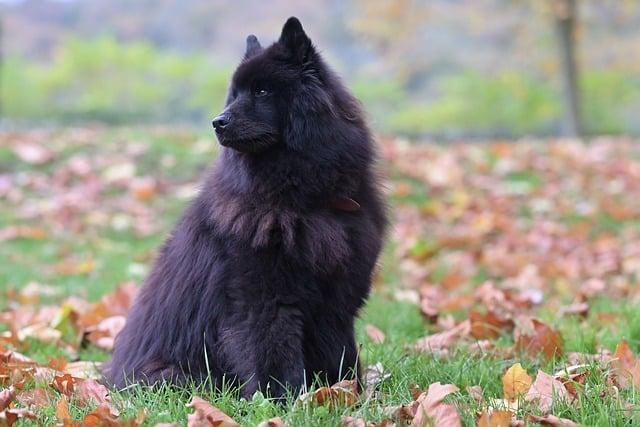Imagine coming home after a long day, and instead of a frantic pup jumping at your feet, you find a calm, contented dog lounging on the couch. Enter the Basenji, a breed known for its independence and low-maintenance nature. While they thrive on companionship, Basenjis are perfectly fine spending a few hours alone, making them ideal for busy professionals. Their unique, cat-like demeanor means they’re not overly needy, allowing you to pursue your passions without guilt. Choose a Basenji, and enjoy the best of both worlds!
Contents
- Understanding the Independence of Dog Breeds Suitable for Alone Time
- Key Characteristics of Low-Socialization Breeds That Thrive Alone
- Creating a Comfortable Environment for Dogs That Are Left Alone
- Expert Recommendations for Training and Socializing Independent Breeds
- Q&A
Understanding the Independence of Dog Breeds Suitable for Alone Time
When considering a dog breed that can comfortably spend time alone, it’s essential to understand the concept of independence in dogs. Some breeds are naturally more self-sufficient and can handle solitude without experiencing anxiety or distress. This independence often stems from their historical roles and the traits that have been selectively bred over generations. For potential dog owners, recognizing these traits can lead to a more harmonious living situation.
Several breeds are renowned for their ability to thrive in solitude. Among them are:
- Basenji: Known as the “barkless dog,” the Basenji is independent and often content to entertain itself.
- Shiba Inu: This breed is known for its spirited personality and can manage alone time quite well.
- French Bulldog: While affectionate, they are also quite adaptable and can handle being left alone for moderate periods.
- Greyhound: Surprisingly, these gentle giants are couch potatoes at heart and enjoy their alone time.
Moreover, the temperament of a dog can significantly influence its ability to be left alone. Breeds that are more laid-back and less prone to separation anxiety tend to fare better when their owners are away. For instance, breeds like the Boston Terrier and Chow Chow are often more relaxed and can enjoy their own company without becoming overly stressed.
It’s also crucial to consider the individual dog’s personality, as not all members of a breed will exhibit the same level of independence. Factors such as early socialization, training, and the dog’s environment play a significant role in shaping their behavior. By providing a safe and stimulating environment, you can help your dog feel more comfortable being alone, regardless of its breed. This understanding will not only enhance your dog’s well-being but also strengthen the bond you share with your furry companion.
Key Characteristics of Low-Socialization Breeds That Thrive Alone
When considering a dog breed that can comfortably spend time alone, it’s essential to understand the unique traits that define low-socialization breeds. These dogs often possess a more independent nature, allowing them to adapt to solitary environments without experiencing significant stress or anxiety. Their temperament is generally calm and self-sufficient, making them ideal companions for individuals with busy lifestyles or those who frequently travel.
One of the most notable characteristics of these breeds is their **low energy levels**. Unlike high-energy dogs that require constant interaction and exercise, low-socialization breeds tend to be more relaxed and content with a quieter lifestyle. This means they can happily entertain themselves while you’re away, whether it’s lounging in a sunny spot or engaging in light play with their toys. Their ability to remain calm and composed makes them less prone to destructive behaviors often associated with boredom.
Another key trait is their **strong sense of independence**. Many low-socialization breeds are naturally inclined to explore their surroundings without needing constant companionship. This independence allows them to thrive in environments where they may not receive immediate attention or interaction. They are often content to observe their surroundings and engage in self-directed activities, which can be particularly beneficial for owners who may not always be available for playtime.
Lastly, these breeds typically exhibit **low attachment levels** to their owners compared to more social breeds. While they still enjoy affection and companionship, they do not rely on constant human interaction for their emotional well-being. This characteristic makes them less likely to suffer from separation anxiety, allowing them to remain calm and secure when left alone. As a result, they can provide a loving presence in your life without demanding excessive attention or companionship.
Creating a Comfortable Environment for Dogs That Are Left Alone
Creating a serene and welcoming atmosphere for dogs that spend time alone is essential for their well-being. A few thoughtful adjustments can transform your home into a haven for your furry friend. Start by designating a specific area that is cozy and secure, equipped with their favorite blanket or bed. This space should be away from high-traffic areas to minimize disturbances and help your dog feel safe and relaxed.
Incorporating engaging toys can significantly alleviate boredom. **Interactive toys** that dispense treats or require problem-solving can keep your dog mentally stimulated while you’re away. Additionally, consider rotating toys regularly to maintain their interest. **Chew toys** and **plush companions** can also provide comfort, making your dog feel less isolated during your absence.
Sound can play a crucial role in creating a comforting environment. Leaving a radio or television on at a low volume can help mask outside noises and provide a sense of companionship. Opt for soothing music or nature sounds, which can have a calming effect on dogs. **White noise machines** are another excellent option, as they can drown out sudden sounds that might startle your pet.
Lastly, ensure your dog has access to fresh water and a safe space to relieve themselves. **Dog gates** can help create a confined area where they can roam freely without the risk of getting into trouble. If possible, consider using a pet camera to monitor your dog while you’re away. This not only allows you to check in but can also provide peace of mind, knowing that your furry friend is comfortable and content in their environment.
Expert Recommendations for Training and Socializing Independent Breeds
When considering independent dog breeds, it’s essential to implement training techniques that foster their natural instincts while ensuring they remain well-behaved companions. **Positive reinforcement** is particularly effective for these breeds. Rewarding desired behaviors with treats, praise, or playtime encourages them to repeat those actions. This method not only builds trust but also strengthens the bond between you and your dog, making them more receptive to training.
Socialization is equally crucial for independent breeds, as it helps them navigate various environments and interactions with other animals and people. Start socializing your dog early, exposing them to different settings, sounds, and experiences. **Gradual exposure** is key; introduce new stimuli slowly to avoid overwhelming them. Consider enrolling your dog in group classes or arranging playdates with other dogs to enhance their social skills in a controlled environment.
Establishing a consistent routine can significantly benefit independent breeds. Dogs thrive on predictability, and a structured schedule for feeding, walks, and playtime can help them feel secure. **Incorporate mental stimulation** into their daily routine, such as puzzle toys or training exercises, to keep their minds engaged. This not only prevents boredom but also reinforces good behavior, making them less likely to engage in destructive activities when left alone.
Lastly, understanding your dog’s unique personality is vital in tailoring your training and socialization approach. Some independent breeds may require more patience and time to adapt to new situations. **Observe their reactions** and adjust your methods accordingly. By respecting their individuality and providing a supportive environment, you can cultivate a well-adjusted dog that thrives in both solitude and social settings.
Q&A
-
Which dog breeds are known to be more independent?
Some dog breeds are naturally more independent and can handle being alone for longer periods. Breeds such as Basenjis, Shiba Inus, and Chow Chows are known for their self-sufficiency and can adapt well to alone time.
-
How long can these breeds typically be left alone?
While it varies by individual dog, many independent breeds can be left alone for 4 to 8 hours a day. However, it’s essential to ensure they have adequate mental stimulation and physical exercise before being left alone.
-
What can I do to help my dog adjust to being alone?
To help your dog adjust, consider the following:
- Provide engaging toys to keep them occupied.
- Establish a consistent routine.
- Gradually increase the time they spend alone.
- Consider using a pet camera to monitor their behavior.
-
Are there any breeds that should not be left alone?
Yes, some breeds thrive on companionship and may experience separation anxiety if left alone for too long. Breeds like Labrador Retrievers, Golden Retrievers, and Cavalier King Charles Spaniels typically require more social interaction and should not be left alone for extended periods.
choosing a dog breed that can comfortably be left alone is essential for both your lifestyle and your pet’s well-being. By selecting a breed known for its independence, you ensure a harmonious relationship that thrives even during your absences.




